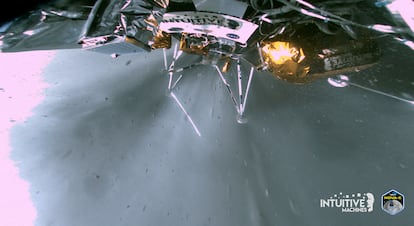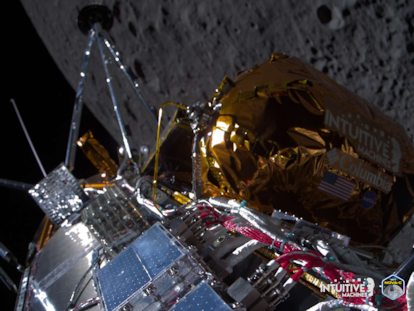Intuitive Machines will try to wake up ‘Odysseus’ when the icy lunar night passes
The company and NASA consider the mission with which the United States has returned to the moon a success despite the setbacks

Odysseus is shutting down. The long lunar night has reached the moon’s south pole and the space module launched by the private company Intuitive Machines has run out of power. Odie, as company employees fondly call the lander, represents the first American moon landing since the end of the Apollo program in 1972. In addition, it has made history by becoming the first device made by a private company to reach the Earth’s natural satellite. Although it has honored its name by having something of an eventful journey, the U.S. space agency NASA and the company both consider that the mission has been a success. Due to the fall it suffered during landing, Odysseus is going into slumber prematurely, but scientists still hope that they will be able to revive it in a few weeks.
Officials for Intuitive Machines and NASA employees who worked on the mission took stock of the IM-1 mission on Wednesday at a news conference at the Johnson Space Center in Houston (Texas).
“We’ve conducted a very successful mission to this point and we expect to go to the end of the mission as planned,” said Steve Altemus, CEO of Intuitive Machines. Altemus insisted time and time again that the important thing about this mission was to reach the moon, achieve a soft landing — although it was not that soft — establish communication and carry out various tests. In his opinion, it has been “an unqualified success.” The company also noted that the deep space liquid methane and liquid oxygen propulsion system designed by themselves has been successfully tested in flight.
Altemus downplayed the fact that the duration of the mission has been shortened by the lunar crash, and instead praised the resistance of the lander: “What a magnificent job that lander did, to touch down on the surface of the moon, softly and safely, and return scientific data to NASA and our customers. It’s just an incredible testament to how robust and, as someone said, beastly that little spacecraft is. We are very happy,” he said enthusiastically as soon as the news conference began.
The module’s energy reserves lasted less than initially projected, but somewhat more than what was feared a couple of days ago. By Wednesday it was already running out of power. Altemus said they would “put Odie to sleep and hope he wakes up in the next two or three weeks.” This option is by no means guaranteed. The Japanese lander that reached the moon a few weeks ago and could not deploy its solar panels after crashing on its side still managed to generate energy last weekend. Odysseus is not especially designed to withstand the frigid temperatures of the long lunar night. Extreme cold could crack electronic components and kill the batteries. Mission director Tim Crain said it’s not clear whether Odysseus will wake up. Sue Lederer, a NASA scientist, was optimistic: “He is a very feisty guy. I have confidence in Odie right now.”
Whether it wakes up or not, Intuitive Machines has achieved what no other company had achieved until now, despite some failed attempts. Altemus was especially jubilant about this point: “What we have done in the process of this mission is that we’ve fundamentally changed the economics of landing on the moon. We have opened the door to a strong and prosperous lunar economy in the future. It’s really a point in history that we should celebrate, as we move toward later missions around the moon.”
Altemus and mission director Crain, chief technology officer at Intuitive Machines, reviewed some of the setbacks that arose during the lunar journey, including the fact that the laser guidance for landing had been physically disabled, forcing engineers to use an alternative method that worked, but not completely. Odysseus missed the desired flat terrain by 1.5 kilometers and ended up at a higher elevation than anticipated. As a result, it descended too quickly and with a vertical and lateral displacement. It hit the ground harder than its legs could tolerate, Altemus explained. The lander momentarily remained upright, with the engine running, before slowly tipping over onto a gentle slope.
This damaged or obstructed some of the antennas, which have been able to transmit less data than originally planned, but still allowed mechanisms to be tested. During the journey there were other failures and unforeseen events (up to 11 “mission critical” challenges have been reported) that the engineers solved as best they could.
“A soft landing on the moon is a great achievement,” Joel Kearns, Deputy Associate Administrator for Exploration in NASA’s Science Mission Directorate, said at the news conference. “This mission is pioneering. It can be considered a flight test.” Sue Lederer, a Commercial Lunar Payload Services (CLPS) project scientist at NASA’s Johnson Center, said agency teams were still analyzing the data but were satisfied with what they were receiving. “All payloads have achieved some level of their objectives.”
NASA Administrator Bill Nelson also called the mission a success, as all six of the space agency’s experiments on the lander were still running Wednesday morning. “There is a big difference between landing a crew and landing a bunch of instruments,” he said at another event, according to statements reported by the Associated Press.
NASA was Intuitive Machines’ main customer, with half of the 12 payloads carried by Odysseus. It has paid the company $118 million to take its work instruments to the moon: a stereoscopic camera to observe the plume of dust that rises during landing; a radio receiver to measure the effects of charged particles on radio signals; an experiment with autonomous navigation capabilities to support future surface and orbital operations; an array of eight retroreflectors that should serve as a permanent position marker on the Moon for decades; the Lidar-based descent and landing sensor that was used as an emergency, and a meter that uses radio waves to determine how much propellant fuel remains in the tanks in a low-gravity environment.
Sign up for our weekly newsletter to get more English-language news coverage from EL PAÍS USA Edition
Tu suscripción se está usando en otro dispositivo
¿Quieres añadir otro usuario a tu suscripción?
Si continúas leyendo en este dispositivo, no se podrá leer en el otro.
FlechaTu suscripción se está usando en otro dispositivo y solo puedes acceder a EL PAÍS desde un dispositivo a la vez.
Si quieres compartir tu cuenta, cambia tu suscripción a la modalidad Premium, así podrás añadir otro usuario. Cada uno accederá con su propia cuenta de email, lo que os permitirá personalizar vuestra experiencia en EL PAÍS.
¿Tienes una suscripción de empresa? Accede aquí para contratar más cuentas.
En el caso de no saber quién está usando tu cuenta, te recomendamos cambiar tu contraseña aquí.
Si decides continuar compartiendo tu cuenta, este mensaje se mostrará en tu dispositivo y en el de la otra persona que está usando tu cuenta de forma indefinida, afectando a tu experiencia de lectura. Puedes consultar aquí los términos y condiciones de la suscripción digital.
More information
Archived In
Últimas noticias
Most viewed
- Pablo Escobar’s hippos: A serious environmental problem, 40 years on
- Reinhard Genzel, Nobel laureate in physics: ‘One-minute videos will never give you the truth’
- Why we lost the habit of sleeping in two segments and how that changed our sense of time
- Charles Dubouloz, mountaineering star, retires at 36 with a farewell tour inspired by Walter Bonatti
- The Florida Keys tourist paradise is besieged by immigration agents: ‘We’ve never seen anything like this’











































